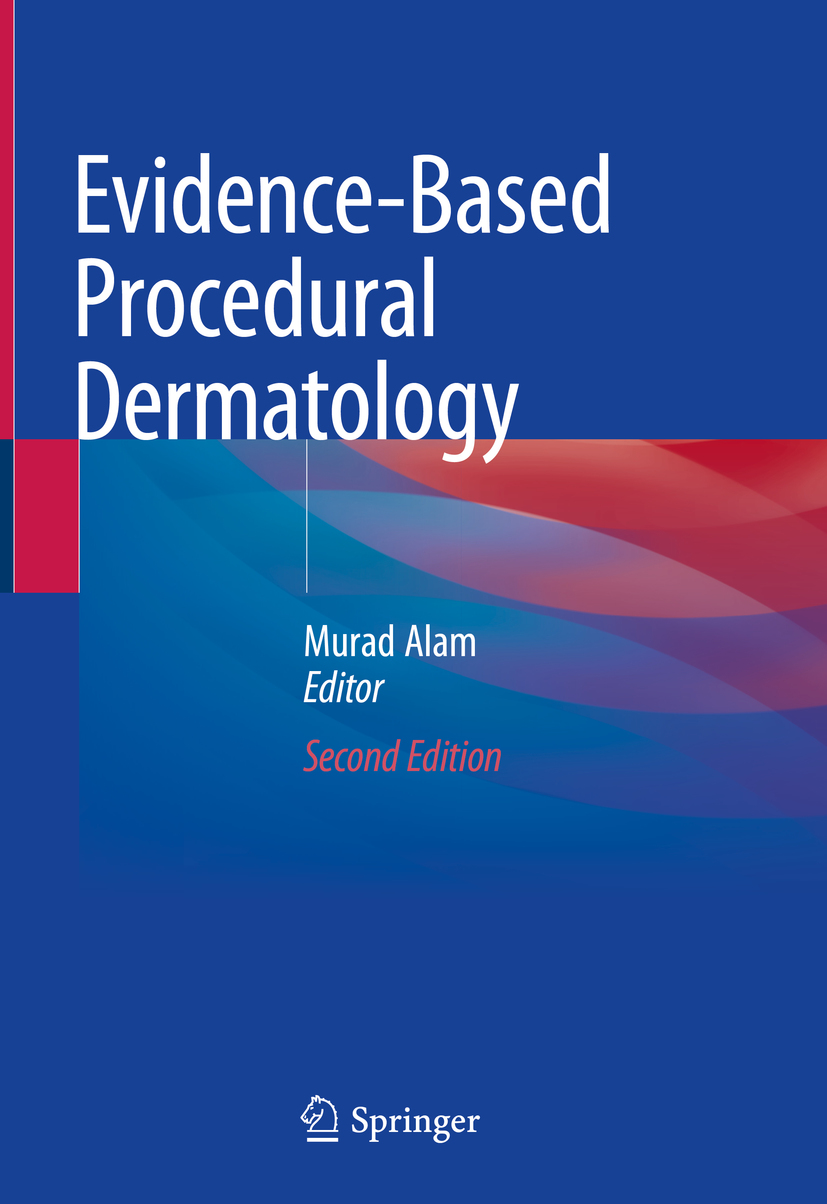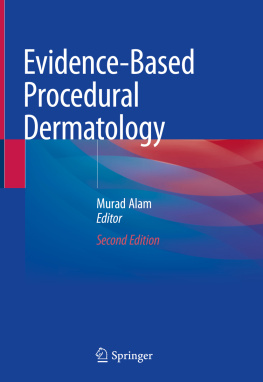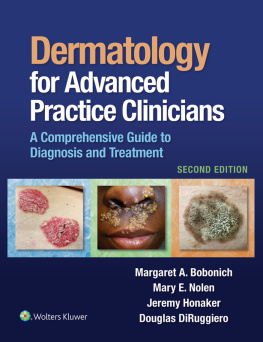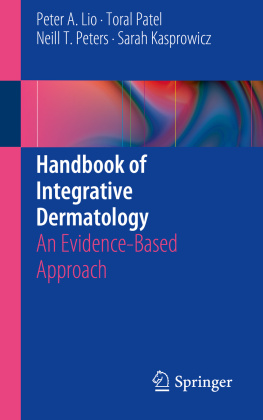Murad Alam - Evidence-Based Procedural Dermatology
Here you can read online Murad Alam - Evidence-Based Procedural Dermatology full text of the book (entire story) in english for free. Download pdf and epub, get meaning, cover and reviews about this ebook. year: 2019, publisher: Springer International Publishing, genre: Romance novel. Description of the work, (preface) as well as reviews are available. Best literature library LitArk.com created for fans of good reading and offers a wide selection of genres:
Romance novel
Science fiction
Adventure
Detective
Science
History
Home and family
Prose
Art
Politics
Computer
Non-fiction
Religion
Business
Children
Humor
Choose a favorite category and find really read worthwhile books. Enjoy immersion in the world of imagination, feel the emotions of the characters or learn something new for yourself, make an fascinating discovery.
- Book:Evidence-Based Procedural Dermatology
- Author:
- Publisher:Springer International Publishing
- Genre:
- Year:2019
- Rating:3 / 5
- Favourites:Add to favourites
- Your mark:
- 60
- 1
- 2
- 3
- 4
- 5
Evidence-Based Procedural Dermatology: summary, description and annotation
We offer to read an annotation, description, summary or preface (depends on what the author of the book "Evidence-Based Procedural Dermatology" wrote himself). If you haven't found the necessary information about the book — write in the comments, we will try to find it.
Evidence-Based Procedural Dermatology — read online for free the complete book (whole text) full work
Below is the text of the book, divided by pages. System saving the place of the last page read, allows you to conveniently read the book "Evidence-Based Procedural Dermatology" online for free, without having to search again every time where you left off. Put a bookmark, and you can go to the page where you finished reading at any time.
Font size:
Interval:
Bookmark:


This Springer imprint is published by the registered company Springer Nature Switzerland AG
The registered company address is: Gewerbestrasse 11, 6330 Cham, Switzerland
To my parents, Rahat and Rehana Alam,
my sister, Nigar Alam, my nephew Ali,
and my (favorite) niece, Noor.
To my mentors, Ken Arndt, Jeff Dover, David Bickers,
Leonard Goldberg, Randy Roenigk, Ron Moy,
June Robinson, Hal Brody, Scott Dinehart,
Desiree Ratner, Bill Coleman, Tri Nguyen,
Elizabeth McBurney, Amy Paller, Dirk Elston,
Alex Miller, and George Hruza.
Since the first edition of this text, much has changed. The methodologic quality of the literature in dermatologic surgery has continued to improve [1, 2]. Journals are encouraging, and authors are accepting, the importance of well-designed studies that are also written up in accordance with appropriate reporting guidelines, like those maintained by Equator [3].
For therapeutic and interventional studies, the importance of carefully selected outcome measures is increasingly apparent. As the Cochrane Collaboration and others have found, research waste can result when the results of small studies cannot be pooled because the outcome measures used are too disparate to reconcile [4, 5]. This problem may ultimately be rectified by the development of core outcome sets, or minimum groups of agreed-upon outcomes that would be employed by all investigators studying a particular disease or condition. In dermatologic surgery, the IMPROVED group is a US-based collaboration working on relevant core outcome sets for the treatment of skin cancers and cosmetic conditions.
High-quality patient-level data may also soon be forthcoming from the many qualified clinical data registries being created by professional specialty societies in the United States. While the presumptive primary incentive for such registries is to facilitate practitioners ability to report required quality metrics to the federal government, the data collected will also be a fruitful resource for a range of clinical questions. Registries in dermatology, such as DataDerm at the American Academy of Dermatology, are currently maturing but within 5 years may be being mined by interested researchers. In dermatologic surgery, the American College of Mohs Surgery has initiated the MohsAIQ Registry, and the American Society for Dermatologic Surgery (ASDS) has planned a registry to track adverse events specifically.
Funds for clinical and comparative effectiveness research in dermatologic surgery are still sparse. A notable bright spot is the ASDS new Brandt grant program, which specifically supports multicenter clinical research in dermatologic surgery. Investigators are learning to work across centers in ways that are cost- and time-efficient.
The first edition ofEvidence-Based Procedural Dermatologywas named after the ACGME-approved advanced fellowship in dermatologic surgery started in 2003. More recently, this fellowship has been modified to exclude most cosmetic procedures and has been renamed Micrographic Surgery and Cutaneous Oncology (MSDO). A new fellowship program, Cosmetic Dermatologic Surgery, has arisen under the auspices of ASDS to fill the training gap in advanced cosmetic and laser procedures. Collectively, there are now about 100 fellowship positions in dermatologic surgery each year, with approximately 1 in 4 US dermatology residents choosing to obtain advanced dermatologic surgery training. Perhaps even more importantly, dermatologic surgery is permeating residency training in dermatology, with young dermatologists better trained in the surgical management of relevant conditions. The techniques pioneered by dermatologic surgeons have also entered other specialties, including plastic surgery, head and neck surgery, ophthalmology, vascular surgery, medical and surgical oncology, and many others. As a consequence, this text is more relevant than ever. The growing cadre of specialists in dermatologic surgery need current, authoritative, and comprehensive information that weighs the benefits and limitations of various treatment approaches for conditions of concern.
We have opted to stay with the moniker Procedural Dermatology, which concisely conveys the breadth of our charge. But the second edition is much expanded from the first. More topics are addressed, and more outstanding chapter authors are included. I am deeply grateful to the many gifted, busy, and generous dermatologic surgeons who have written this book.
Alam M, Rauf M, Ali S, Nodzenski M, Minkis K. A systematic review of reporting in randomized controlled trials in Dermatologic Surgery: Jadad scores, power analysis, and sample size determination. Dermatol Surg. 2014;40(12):1299305.
Alam M, Rauf M, Ali S, Patel P, Schlessinger DI, Schaeffer MR, Yoo SS, Minkis K, Jiang SI, Maher IA, Sobanko JF, Cartee TV, Poon E. A systematic review of completeness of reporting in randomized controlled trials in dermatologic surgery: adherence to CONSORT 2010 recommendations. Dermatol Surg. 2016;42(12):132534.
Simera I, Moher D, Hirst A, Hoey J, Schulz KF, Altman DG. Transparent and accurate reporting increases reliability, utility, and impact of your research: reporting guidelines and the EQUATOR Network. BMC Med. 2010;8:24. https://doi.org/10.1186/1741-7015-8-24 .
Schmitt J, Deckert S, Alam M, Apfelbacher C, Barbaric J, Bauer A, Chalmers J, Chosidow O, Delamere F, Doney E, Eleftheriadou V, Grainge M, Johannsen L, Kottner J, Le Cleach L, Mayer A, Pinart M, Prescott L, Prinsen CA, Ratib S, Schlager JG, Sharma M, Thomas KS, Weberschock T, Weller K, Werner RN, Wild T, Wilkes SR, Williams HC. Report from the kick-off meeting of the Cochrane Skin Group Core Outcome Set Initiative (CSG-COUSIN). Br J Dermatol. 2016;174(2):28795.
Font size:
Interval:
Bookmark:
Similar books «Evidence-Based Procedural Dermatology»
Look at similar books to Evidence-Based Procedural Dermatology. We have selected literature similar in name and meaning in the hope of providing readers with more options to find new, interesting, not yet read works.
Discussion, reviews of the book Evidence-Based Procedural Dermatology and just readers' own opinions. Leave your comments, write what you think about the work, its meaning or the main characters. Specify what exactly you liked and what you didn't like, and why you think so.













